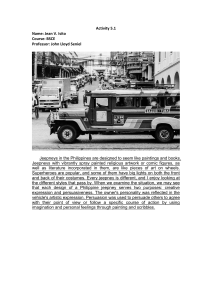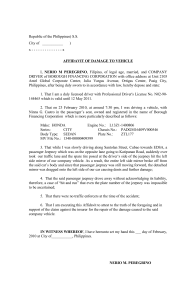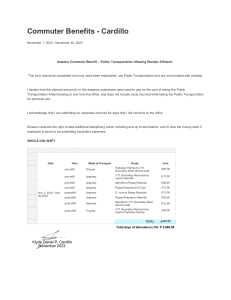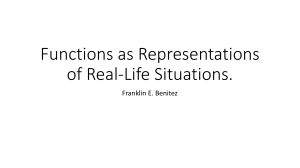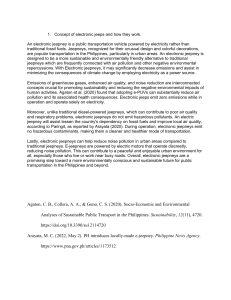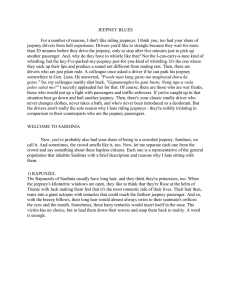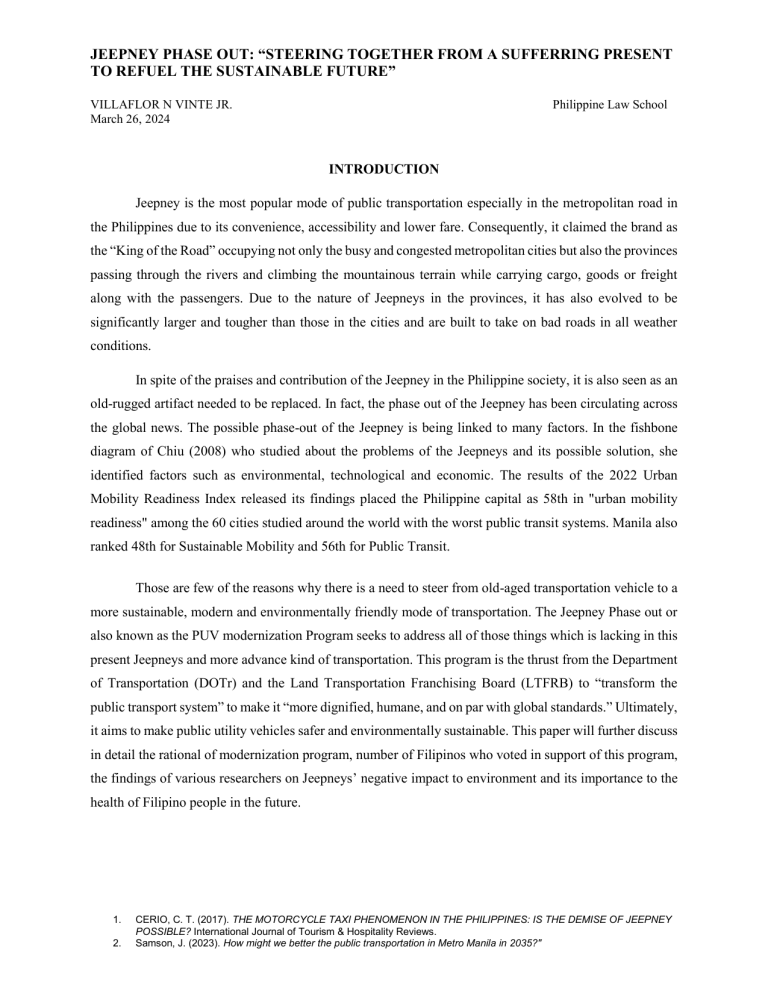
JEEPNEY PHASE OUT: “STEERING TOGETHER FROM A SUFFERRING PRESENT TO REFUEL THE SUSTAINABLE FUTURE” VILLAFLOR N VINTE JR. March 26, 2024 Philippine Law School INTRODUCTION Jeepney is the most popular mode of public transportation especially in the metropolitan road in the Philippines due to its convenience, accessibility and lower fare. Consequently, it claimed the brand as the “King of the Road” occupying not only the busy and congested metropolitan cities but also the provinces passing through the rivers and climbing the mountainous terrain while carrying cargo, goods or freight along with the passengers. Due to the nature of Jeepneys in the provinces, it has also evolved to be significantly larger and tougher than those in the cities and are built to take on bad roads in all weather conditions. In spite of the praises and contribution of the Jeepney in the Philippine society, it is also seen as an old-rugged artifact needed to be replaced. In fact, the phase out of the Jeepney has been circulating across the global news. The possible phase-out of the Jeepney is being linked to many factors. In the fishbone diagram of Chiu (2008) who studied about the problems of the Jeepneys and its possible solution, she identified factors such as environmental, technological and economic. The results of the 2022 Urban Mobility Readiness Index released its findings placed the Philippine capital as 58th in "urban mobility readiness" among the 60 cities studied around the world with the worst public transit systems. Manila also ranked 48th for Sustainable Mobility and 56th for Public Transit. Those are few of the reasons why there is a need to steer from old-aged transportation vehicle to a more sustainable, modern and environmentally friendly mode of transportation. The Jeepney Phase out or also known as the PUV modernization Program seeks to address all of those things which is lacking in this present Jeepneys and more advance kind of transportation. This program is the thrust from the Department of Transportation (DOTr) and the Land Transportation Franchising Board (LTFRB) to “transform the public transport system” to make it “more dignified, humane, and on par with global standards.” Ultimately, it aims to make public utility vehicles safer and environmentally sustainable. This paper will further discuss in detail the rational of modernization program, number of Filipinos who voted in support of this program, the findings of various researchers on Jeepneys’ negative impact to environment and its importance to the health of Filipino people in the future. 1. 2. CERIO, C. T. (2017). THE MOTORCYCLE TAXI PHENOMENON IN THE PHILIPPINES: IS THE DEMISE OF JEEPNEY POSSIBLE? International Journal of Tourism & Hospitality Reviews. Samson, J. (2023). How might we better the public transportation in Metro Manila in 2035?" JEEPNEY PHASE OUT: STEERING TOGETHER FROM A SUFFERRING PRESENT TO REFUEL THE SUSTAINABLE FUTURE PUV MODERNIZATION PROGRAM: FUEL FOR THE SUSTAINABLE FUTURE In 2017, the government, through the Department of Transportation (DOTr), embarked on a Public Utility Vehicle Modernization Program (PUVMP) as a move towards changing the landscape of public transportation in the Philippines. This is in response to the prevalent challenges brought about by the continued increase in motor vehicles in the country especially in urban areas which lead to traffic congestion, air pollution, and reduced road capacity, among others. Contributing to the motor vehicle growth rate is the continuous operation of public utility Jeepneys (PUJs), majority of which are already 15 years old and above. The lack of mandatory age limit for PUJs allows vehicles to ply around despite old age. The commuting public’s safety from road accidents is also put at risk due to the questionable roadworthiness of these PUJs. As more PUJs are deemed unsafe and unreliable, individuals are incentivized to rely on privately-owned vehicles instead of public conveyances. Consequently, automobile dependency or the level of vehicle ownership rises which exacerbates the traffic congestion. (CPBRD). This growing of numbers in Jeepneys on the road may not be too alarming for many off course, on the reason that most of us merely inclined on the premise that “to see is to believe” but the same cannot be ignored, as the law of nature supported by scientific evidence dictates that it would likely brought this result sooner if no immediate action should be done. It is better to prepare for the incoming atmospheric contamination based on the smoke emitted by these old-engine of Jeepneys. Now is the high time to act, let us make this first step to kick the goal we want, the greener environment for Filipino? PULSE OF FILIPINO MAJORITY 7 out of 10 Filipinos, A significant majority or 70 percent of adult Filipinos expressed support for the government’s public utility vehicle modernization program (PUVMP), according to the results of a survey conducted by research and analytics firm Capstone-Intel Corp. The survey, conducted from Nov. 22-29 involving 1,503 respondents, showed that 70 percent of the respondents approved of the government's performance on PUV modernization, with 41 percent rating the program as "good" and 29 percent giving it a "very good" performance rating (PNA 2023). It cannot be denied that masses were now ready and in fact they are willing to abandoning the idealistic of old Jeepney to this present era. It is not about forgetting the history of Jeepney but this is to preserve the incoming future from possible negative impact if this Jeepney operations will continue. 1. 2. 3. 4. 5. 6. Congressional Policy and Budget Research Development: Looking into the implementation of PUVMP PNA-https://www.pna.gov.ph/articles/1215495 Luis Liwanag and Jojo Riñoza 2023. BN Agaton, C., et. al., (2019) ‘Diesel or Electric Jeepney? A case Study of Transport Investment in the Philippines Using the Real Options Approach’, World Electric Vehicle Journal Kuzuma, N. (2023). Is Jeepney Phase-Out a Just Transition to Sustainable Transport System? Green Network.Asia. GR No. 110861 JEEPNEY PHASE OUT: STEERING TOGETHER FROM A SUFFERRING PRESENT TO REFUEL THE SUSTAINABLE FUTURE Modern time needs modern tools and no one could ever deny that most of us being the generation of “Gen Z” preferred technology for its efficient and fast transaction. If these program is fortunate enough to wipe out the current system of transportation, it will create a form of transportation that is relevant with technology such as the installation of air conditions, CCTV, Dashboard Cameras and Speed detector units. This is to enhance the safety measures for the souls loaded inside such common carrier and most of them have family to feed and relied upon, safety is a must. Some striking people categorically argued that the program is nothing but sticking the people into poverty because many of them will lose their livelihood and the same could delete the Filipino identity of transportation. Certainly, this voice echoed from those people who did not open their eyes to visualize and value the days to come. This program will enhance the system of routes and would potentially pay the drivers with fixed-salary scheme regardless of their “Barya lang po sa Umaga” income. Is it not an assurance especially being a breadwinner? If Jeepneys lacks technological, environmental and sometimes economical safety means so why should still choose Jeepney? Just to protect Filipino identity and pride? Or to protect the next generation’s environmental stability and well-being? What is the culture or symbol as Filipino people for, if our successors will blame us for the poor system in the Philippines? That so called depletion of adapted culture and mythical poverty as a result thereof, or to more sustainable and advance Public transportation? Let us be inclined to the latter. SMOKE EMISSION AND ITS ENVIRONMENTAL IMPACT “They will take away our right to be on the streets, they are taking away our right to earn a living,” said Julius Aniban Aban, 52, a Jeepney driver for three decades. “At my age, do you think any establishment would still hire me should Jeepneys be phased out?” Inasmuch as being a Filipino, it’s hard to hear such words from my “Kababayan”. However, I cannot trade that off to the fact that this Jeepneys emissions contributed to certain amount of Sulphuric and Nitrogenic oxide which is harmful to the environment and would cause to contribute for the pollution in our country especially in Greater Manila Area. Those particulate that accumulated will later on be faced by our countrymen and they may suffer health problems. Currently, the transport sector accounts for 23% of global energy-related CO₂ emissions and is continuously growing due to increasing passenger and freight activity. As shipping, and heavy-duty roads are the most difficult modes to decarbonize, the electrification of passenger cars and public utility vehicles (PUVs) appears to have the potential to reduce GHG emissions and other pollutants. According to government data, around 65% of Jeepneys and 75% of UV Express units have already been consolidated. 1. 2. 3. 4. 5. 6. Congressional Policy and Budget Research Development: Looking into the implementation of PUVMP PNA-https://www.pna.gov.ph/articles/1215495 Luis Liwanag and Jojo Riñoza 2023. BN Agaton, C., et. al., (2019) ‘Diesel or Electric Jeepney? A case Study of Transport Investment in the Philippines Using the Real Options Approach’, World Electric Vehicle Journal Kuzuma, N. (2023). Is Jeepney Phase-Out a Just Transition to Sustainable Transport System? Green Network.Asia. GR No. 110861 JEEPNEY PHASE OUT: STEERING TOGETHER FROM A SUFFERRING PRESENT TO REFUEL THE SUSTAINABLE FUTURE The LTFRB also claims that 90% of transport groups support the program. Additionally, a study from 2019 revealed that most commuters prefer to ride e-Jeepneys over conventional ones when available. On the other hand, some transport groups deem the Jeepney phase-out anti-poor as it puts the burden of buying new vehicles on drivers and operators. “It’s OK to have modernization for those who have money,” said Jeepney driver Benito Garcia. “But for us Jeepney drivers and operators, we cannot afford.” Contrary to such argument, it was clear from the purpose of the said PUVMP and its solution to give incentive to those who are affected. This move of the government in fact done by a thorough research and further taking into consideration the sake of every Filipino people who are most vulnerable. The state did not degrade her subordinates by not taking into account social justice and sustainability for all. No more argument as to the promotion of social justice and environmental safety at the same time. Government is aware that sustainability is more than just the environment. In pursuing a better future, we must leave no one behind. Climate actions should go hand-in-hand with social justice. It is not easy, but it is possible. All policies, innovations, and actions require robust multi-stakeholder participation and ensure the protection of the most vulnerable of the population. In conclusion, this Jeepney phase out is the response of the state to our suffering status in terms of environmental stability, and systematic road management involving Jeepney. In the exercise of its police power and being the parents patriae, it sought to protect its people from the cause of Jeepney emissions in environmental destruction. Contrary to the claim of some people that it is unjust to poor and such policy is in contravention of social justice. Clearly, Social justice is "neither communism, nor despotism, nor atomism, nor anarchy," but the humanization of laws and the equalization of social and economic forces by the State so that justice in its rational and objectively secular conception may at least be approximated. Social justice means the promotion of the welfare of all the people, the adoption by the Government of measures calculated to insure economic stability of all the component elements of society, through the maintenance of a proper economic and social equilibrium in the interrelations of the members of the community, constitutionally, through the adoption of measures legally justifiable, or extra-constitutionally, through the exercise of powers underlying the existence of all governments on the time-honored principle of salus populi est suprema lex (Calalang vs. Williams 1994) 1. 2. 3. 4. 5. 6. Congressional Policy and Budget Research Development: Looking into the implementation of PUVMP PNA-https://www.pna.gov.ph/articles/1215495 Luis Liwanag and Jojo Riñoza 2023. BN Agaton, C., et. al., (2019) ‘Diesel or Electric Jeepney? A case Study of Transport Investment in the Philippines Using the Real Options Approach’, World Electric Vehicle Journal Kuzuma, N. (2023). Is Jeepney Phase-Out a Just Transition to Sustainable Transport System? Green Network.Asia. GR No. 110861 JEEPNEY PHASE OUT: STEERING TOGETHER FROM A SUFFERRING PRESENT TO REFUEL THE SUSTAINABLE FUTURE I Villaflor N. Vinte Jr., hereby declares that the “Position Paper” hereto submitted electronically in accordance with the Efficient Paper Use Rule are complete and that I have caused the preparation of the same based on my personal knowledge and thorough research. IN WITNESS WHEREOF, I have hereunto set my hand this 26th day of Mach 2024 at Lanao Del Norte, Mindanao. VILLAFLOR N VINTE JR. 1. 2. 3. 4. 5. 6. Congressional Policy and Budget Research Development: Looking into the implementation of PUVMP PNA-https://www.pna.gov.ph/articles/1215495 Luis Liwanag and Jojo Riñoza 2023. BN Agaton, C., et. al., (2019) ‘Diesel or Electric Jeepney? A case Study of Transport Investment in the Philippines Using the Real Options Approach’, World Electric Vehicle Journal Kuzuma, N. (2023). Is Jeepney Phase-Out a Just Transition to Sustainable Transport System? Green Network.Asia. GR No. 110861
